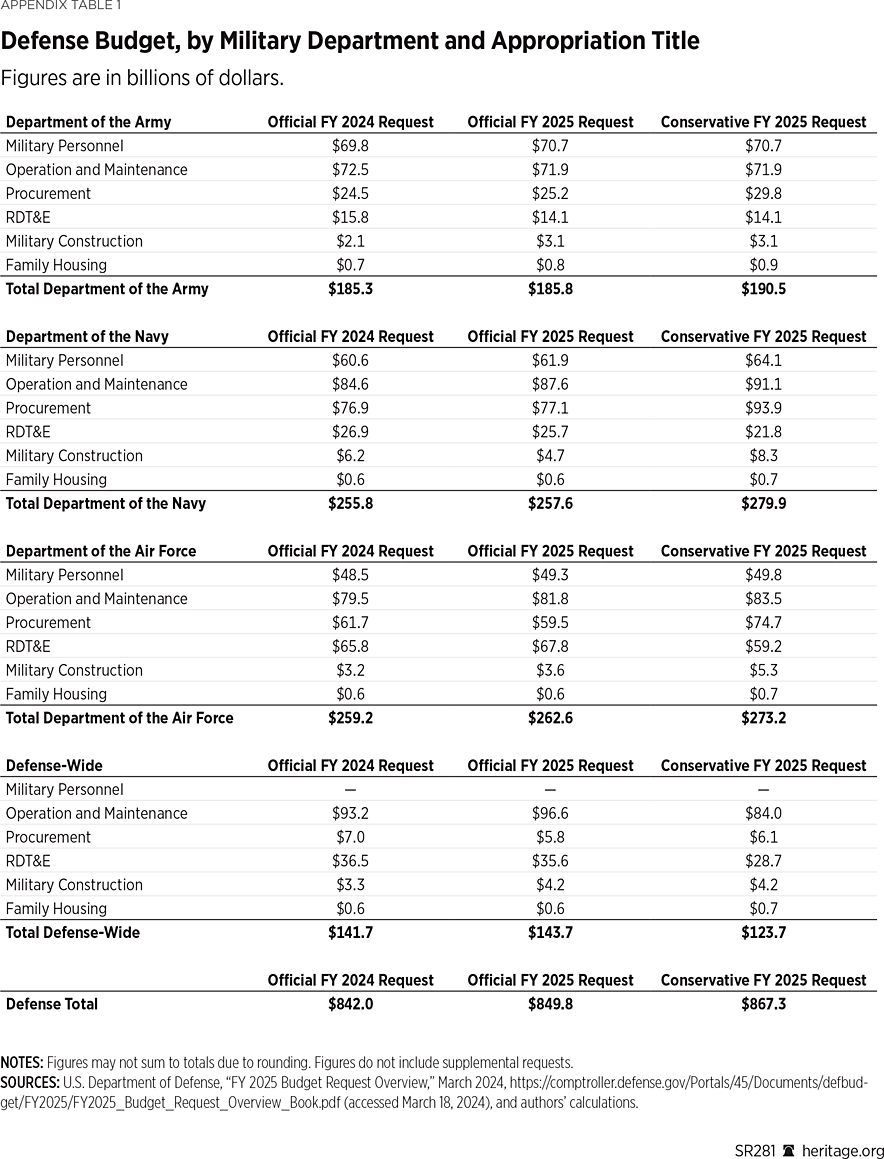This Special Report on the conservative defense budget for fiscal year (FY) 2025 provides a road map for the defense budget that addresses significant weaknesses identified in The Heritage Foundation’s annual Index of U.S. Military Strength while remaining mindful of America’s woeful fiscal predicament. It reflects years of research and analysis by Heritage defense and budget experts, with recommendations drawn from dozens of Heritage reports. This document provides both a topline funding recommendation for the Department of Defense (DOD) as a whole and more detailed recommendations within each service’s budget. It also recommends priorities within budget increases, especially for procurement. To fund these increases, the Special Report recommends topline cuts to certain accounts for dollars that can be reallocated as well as individual items that can be cut and reallocated within the budget if additional funding is needed for the identified priorities.
Overview of the FY 2025 Conservative Defense Budget
President Joe Biden released his official FY 2025 Defense Budget Request in March 2024.REF In this document, his Administration’s misguided priorities are on full display. While paying lip service to the concept of China as the primary challenge for the United States, the official request fails to align spending with strategy. Most egregiously, the request fails to procure the ships, aircraft, and munitions the military needs to deter China in the Indo-Pacific. It is, in a word, insufficient to keep the American people safe.
By contrast, to account for the historically high inflation levels throughout this Administration’s tenure and to provide a real increase in military capacity, the FY 2025 conservative budget calls for a roughly 3 percent overall increase over the official FY 2024 request (as opposed to the 1 percent increase called for in the President’s FY 2025 request) with procurement accounting for the majority of new funding. It also calls for procurement in addition to that new spending, to be funded by shifts from elsewhere within the defense budget.
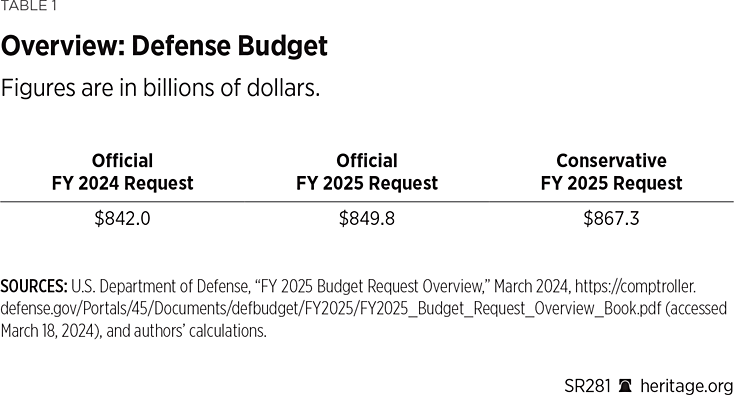
Procurement Focus. Ships, aircraft, and munitions are the basis of real military capacity that potential adversaries are prioritizing and need to be similarly prioritized within the U.S. defense budget. When faced with budget constraints, the services invariably cut procurement. In the official FY 2025 request, for example, the Navy chose to cut a Virginia-class submarine and the Air Force chose to cut its procurement of F35 fighter jets. Meanwhile, the Air Force increased its Research, Development, Test, and Evaluation (RDT&E) budgets, and the Navy proposed to hire an additional 2,000 civilian employees.
But procurement of critical capabilities, such as ships and aircraft, should be the last place the DOD chooses to cut when faced with budget constraints, particularly under current circumstances. Ideally, the DOD should cut bloat, waste, and non-military spending within the budget to pay for necessary procurement. In addition to cutting waste, the DOD will have to cut RDT&E programs of secondary importance, as well as Operation and Maintenance (O&M) or Personnel, to pay for necessary procurement. The Heritage Foundation’s FY 2025 conservative defense budget therefore advocates the procurement of additional ships, aircraft, and munitions accompanied by cuts elsewhere in the defense budget.
Shift from RDT&E to Procurement. Within RDT&E, the DOD must focus spending on the projects that are most likely to produce real military capacity, like the Next Generation Air Dominance (NGAD) platform. Generalized RDT&E projects, or RDT&E projects of secondary importance, must be cut and reallocated to the procurement of ships, planes, and munitions.
In FY 2023, the DOD was authorized to spend $140 billion for RDT&E and $167 billion for procurement, making RDT&E equal to about 84 percent of procurement.REF From FY 2022 to FY 2023, RDT&E’s combined budget authority increased by $21 billion, and procurement spending increased by about $13.5 billion. From FY 2021 to FY 2022, spending on RDT&E increased by $13 billion, and spending on procurement increased by $4.7 billion.REF
These numbers are imbalanced. It is, of course, important to invest in the future of the force, but not at so high a level that it detracts from the military’s ability to field equipment and munitions that already exist for the security concerns of the present. The DOD must shift funding from RDT&E accounts into Procurement and O&M.
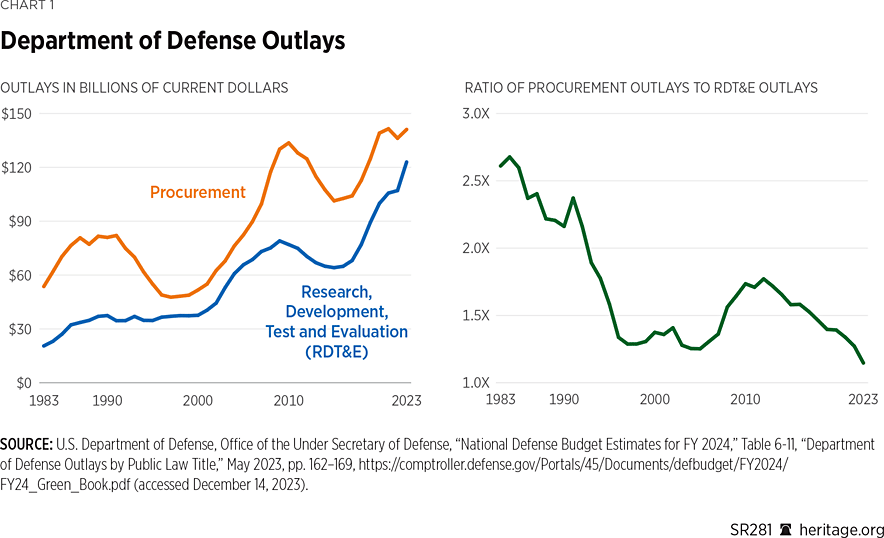
Focus on the Indo-Pacific. The conservative defense budget reflects the realization that some degree of prioritization is necessary within strategic planning and that defense spending should flow from strategy. While being mindful of the multitude of threats America faces, in accordance with the past two National Defense Strategies (NDS), the conservative defense budget recognizes China as the primary challenge to the United States and allocates resources accordingly.
Strategic Deterrence. As the 2024 Index of U.S. Military Strength lays out, China and Russia have significantly improved their nuclear strategic arsenals in recent years while U.S. capabilities have atrophied. One of this conservative defense budget’s most significant investments is in America’s own strategic arsenal. The strategic arsenal is the backstop and cornerstone of American security and therefore requires significant investment.
Defense Reforms. As public servants, DOD officials have a duty to the American public to spend their money wisely. The DOD should be aggressive in cutting and reallocating waste and inefficiencies both because it is its duty and because waste and inefficiency limit the military’s ability to achieve its prime objective: being a lethal fighting force capable of defending the American people and their interests. This Special Report recommends that $18.8 billion in cuts to defense-wide O&M and RDT&E accounts be shifted to military service spending on procurement and Navy and Air Force O&M. The intent is for more military spending to be directed more to the warfighter and less toward the bloated bureaucracies at the defense agencies.
Unlike President Biden’s defense budget request, this Special Report does not ask for more DOD civilian employees. Instead, it asks for cuts to budgets at DOD civilian agencies and for Congress to institute reforms to increase the DOD’s ability to hire competent employees and fire incompetent employees in order to increase efficiency at all levels.REF
The Defense Industrial Base. The large increases in procurement of military equipment and munitions in the FY 2025 conservative defense budget represent a serious capital stock investment in the American defense industrial base. This investment will enable industry to make long-term investments in the manufacturing capacity and workforce that America needs to build and maintain a lethal and capable military capable of defending American national security interests.
The conservative defense budget recommends approximately $8 billion over what the Administration has requested for munitions procurement as well as $48.1 billion for sea-power investments with new construction of nine battle force fleet ships including one Columbia-class submarine and two Virginia-class submarines, two Arleigh Burke–class destroyers, and two Constellation-class guided-missile frigates. The Biden Administration’s request critically fails to request funding for a second Virginia-class submarine and a second Constellation-class frigate. These increased capital investments in the defense industrial base will help to address deficiencies in labor, investment, and capacity.
The Strategy of Denial
The strategy of denial’s primary objective is to deny Chinese hegemony in the Indo-Pacific even as U.S. forces defend the U.S. homeland and work closely with allies and partners to counter other threats. The United States faces an increasingly dangerous world, and it has limited resources with which to confront all the threats to the nation—a reality that President Biden’s defense budget request regrettably does not recognize. As a result, it is increasingly vital for the United States—and the DOD in particular—to prioritize the Indo-Pacific. That means focusing U.S. forces first and foremost on defending the U.S. homeland and denying China’s imperial ambitions while supporting U.S. allies and partners to lead efforts to defend against other threats. In doing so, the United States can protect Americans’ security, freedom, and prosperity while also strengthening America’s alliances and partnerships around the world so that they, too, can live without fear.
Defending the Homeland and Denying China’s Imperial Ambitions. The DOD’s fundamental responsibility is to defend the U.S. homeland. It should do so first by strengthening the nation’s nuclear deterrent. This is vital to prevent enemies from using nuclear or other weapons of mass destruction (WMDs) against the U.S. homeland. At the same time, the DOD should strengthen U.S. missile defenses with a focus on being able to defeat limited missile salvos by China, Russia, or North Korea. This capacity is critical to prevent those adversaries from using threats of limited nuclear attacks on the U.S. homeland to compel Washington to abandon U.S. interests in other regions.
Finally, the U.S. military has long played a vital role in securing the nation’s sovereignty—and still must, especially given the continuing security and humanitarian crisis at the Southern border. The DOD must do this by supporting law enforcement and homeland security agencies’ efforts to monitor and interdict traffic at the U.S. border. It must also provide support for regional partners in the shared fight against traffickers and options for direct action against related threats.
But defending the U.S. homeland will not be enough by itself to protect America’s security, prosperity, and freedom. To do that, the United States must also deny China’s bid for hegemony in the Indo-Pacific. If the United States fails in this mission, then Beijing will be able to restrict Americans’ access to many of the world’s most important markets with dire implications for American workers and producers. Beijing will also be able to harness the region’s wealth for its own purposes, fueling China’s rise in the face of domestic challenges and ultimately positioning Beijing to contend for global hegemony.
This grim future can be avoided—and the U.S. military has a vital and unique role to play in doing so. If Beijing believes that it will be permitted to use military force to subdue its neighbors, then that is what it will do. The DOD’s task is to make clear that it cannot—thereby deterring Chinese aggression and rallying the nations of the Indo-Pacific to resist China’s imperial advances.
To that end, the DOD should retain a single-war force planning construct adopted by the 2018 National Defense Strategy (NDS) and upheld by the 2022 NDS with China as the DOD’s pacing threat and a Chinese fait accompli against Taiwan as its pacing scenario. Consistent with this framework, the DOD will prioritize urgently strengthening U.S. and allied forces’ ability to deny a successful Chinese operation against Taiwan by rapidly dispersing U.S. forces in the Western Pacific, intensifying intelligence-gathering about Chinese forces, and building stockpiles of weapons in the region needed by U.S. forces to deny a Chinese invasion. The DOD will also support interagency efforts to prioritize arming Taiwan.
Strengthening Burden-Sharing to Deter Russia, Iran, and North Korea. Prioritizing China does not mean ignoring other threats, but if the DOD is to defend the U.S. homeland and deny China’s imperial ambitions, it will be forced to do less in other areas. In Europe, that will require dramatic changes in the North Atlantic Treaty Organization (NATO). As it stands, allies expect the United States to provide many of the forces required to deter or defeat a Russian assault on NATO’s eastern front, but many of those finite forces are also needed to deter or defeat China. As a result, as long as Washington is prioritizing China, it will be unable to provide these forces for Europe on the scale the continent expects.
This is the reality with which NATO must grapple—and U.S. allies must do so quickly. Specifically, they must take primary responsibility for Europe’s conventional defense by fielding most, if not all, of the conventional forces required to deter or deny Russian aggression against the Baltics, Poland, or Finland. This will allow NATO to deter Russia even as the DOD reassigns certain forces to the Indo-Pacific and divests itself of other capabilities.
At the same time, NATO allies must also take the lead in providing military aid to Ukraine, which will require additional arms to offset or overcome Russia’s manpower and materiel advantages for an indeterminate period of time. This will be vital to free U.S. stockpiles and production capacity—especially as the U.S. defense industry ramps up from its post–Cold War nadir—for higher priorities such as homeland defense, deterring China, and assistance to Israel.
The DOD must facilitate this transfer of responsibilities within NATO in coordination with other U.S. agencies. It should do so first by identifying forces requiring replacement, supporting U.S. and allied efforts to field those forces, and setting clear timelines for the transfer of certain U.S. forces from Europe to incentivize allied investments. U.S. forces will still provide an extended nuclear deterrent to NATO. Finally, the DOD should provide select conventional forces to NATO that do not detract from its ability to deter China.
The DOD will also support similar measures to support allies and partners in the Middle East. That support starts with providing Israel with the arms, intelligence, and other support that it requires to defend itself against Iran and its proxies. The DOD will work with other agencies to expedite delivery of weapons and other support to partners in the Gulf even as it leads efforts to enhance integration between Israel and those Gulf partners. Under this approach, Washington—the DOD in particular—will prepare regional partners to lead efforts to deter and defend against Iranian aggression, building on the progress of the Abraham Accords and related initiatives.REF
U.S. forces will still play an important role in the Middle East, including by maintaining—or, as required, by developing—the ability to hold Iran’s nuclear facilities at risk. U.S. forces must maintain the ability to impose severe costs on Iran’s leaders lest they believe they can harm Americans or U.S. interests with impunity. U.S. forces also will be required to neutralize terrorists who might strike the U.S. homeland.
Finally, the United States has an interest in deterring North Korea, even as it prioritizes homeland defense, and denying China’s imperial ambitions. To that end, in coordination with other U.S. agencies, the DOD will keep working to prepare South Korea to take the lead in defending against a North Korean invasion. At the same time, the DOD will work with counterparts in South Korea and Japan to develop and field a larger array of cost-effective theater missile defenses while also strengthening U.S. homeland missile defenses and fielding a more diverse set of U.S. nuclear options. These investments will help to deter—or, if necessary, to limit damage caused by—North Korean attacks on the United States or U.S. allies.
Hard Choices. Even if the United States raises defense spending significantly in the coming years, it will take years more to convert those spending increases into combat power. The United States will therefore be required to rely more heavily on its allies and partners to deter and defend against threats from Russia, Iran, and North Korea while U.S. forces focus first on defending the U.S. homeland and denying China’s imperial ambitions.
This is an uncomfortable reality for many in Washington—but it is a reality nonetheless. If the U.S. sets the right priorities, there is every reason to believe that it will be able to defend the homeland effectively while also denying China’s imperial ambitions and strengthening alliances and partnerships in the face of persistent threats from Russia, Iran, North Korea, and others. If the U.S. does not set the right priorities—if it persists in overextending U.S. forces, thereby weakening not only U.S. defenses, but also any incentives that allies and partners might have to strengthen their own—then the U.S. should only expect further chaos and war as it has begun to see in recent years.
Resourcing the Strategy of Denial
A strategy of denial will be possible only if the military is adequately resourced with the ships, planes, and munitions it needs. The conservative defense budget therefore supports:
- $6.2 billion for the Columbia-class ballistic missile submarine;
- $5.3 billion for the B-21 bomber;
- $61.1 billion for air power focused on F-22, F-35, and F-15EX fighters, the B-21 bomber, mobility aircraft, KC-46A tankers, and unmanned aircraft systems;
- $48.1 billion for sea-power investments with new construction of nine battle force fleet ships including one Columbia-class submarine and two Virginia-class submarines, two Arleigh Burke–class destroyers, and two Constellation-class guided-missile frigates;
- $33.3 billion in vital space capabilities, resilient architectures, and enhanced space command and control.
In addition:
- The F-35 program is developing, producing, and fielding three variants of a 5th generation strike fighter: (1) the Air Force F-35A Conventional Take-Off and Landing variant; (2) the Marine Corps F-35B Short–Take Off and Vertical Landing (STOVL) variant; and (3) the Navy F-35C Carrier variant. The F-35’s stealth, advanced sensors, and interoperability allow seamless information exchanges that make all warfighters in the battlespace smarter, more lethal, and more survivable.
- The FY 2025 conservative defense budget continues procurement of the KC-46A aerial refueling tanker, which will replace aging legacy tankers. The KC-46A provides increased refueling capability for Navy and Air Force aircraft. The conservative defense budget funds the Air Force’s replacement of its aging fleet of E-3 Sentry Airborne Warning and Control System aircraft with a version of the E-7 Wedgetail.
- The FY 2025 conservative budget funds development of the B-21 Raider long-range strike bomber and modernization of the existing bomber fleet of B-52s, B-1s, and B-2s. The budget funds B-52 mission systems and communications upgrades as well as replacement for the B-52’s inefficient and aging engines.
- The FY 2025 conservative budget continues incremental funding for the Gerald R. Ford–class nuclear aircraft carriers—the USS John F. Kennedy (CVN 79); USS Enterprise (CVN 80); and USS Doris Miller (CVN 81)—and accelerates procurement of one landing helicopter assault (LHA) America-class amphibious assault ship from FY 2031 to FY 2027. The FY 2025 request also continues funding for systems development for Landing Craft Air Cushion (LCAC) 101; a Service Life Extension Program (SLEP) and recapitalization of the Landing Craft Utility (LCU) 1700 to support amphibious assault capability; procurement of two guided-missile destroyers (DDG) 51 Flight III variant ships; two new Constellation-class frigates to address the Navy’s small-surface-combatant requirements for a more lethal and capable follow-on to the Littoral Combat Ship. In addition, it expands sea-power strike capacity by continuing funding for offensively armed unmanned surface vessels (USVs) and unmanned undersea vehicles (UUVs) and also provides funding for one additional fleet replenishment oiler ship (T-AO) to continue recapitalizing these important assets.
The Deterrence Component of Denial
Modernizing the nation’s strategic deterrent is the Department of Defense’s top priority, and these programs are funded in the FY 2025 conservative budget request. The DOD has steadily received strong, bipartisan congressional support for the nuclear deterrence modernization mission. Most of the nation’s strategic arsenal, including warheads and delivery systems, built in the 1980s and prior years, are reaching or are already beyond their end of service life, with all currently fielded systems having been extended significantly—in some cases, decades past their service lives.
Replacement programs are underway to ensure that there are no gaps in capability when the legacy systems age out. Such programs are necessary but wholly insufficient to deter strategic attacks on the United States and its allies. The nuclear modernization program of record of modernizing the triad must be augmented by a larger and more diversified nuclear arsenal given the breathtaking expansion of the Chinese nuclear arsenal, the almost daily nuclear threats emanating from Moscow, North Korea’s steady expansion of its nuclear capabilities, and Iran’s status as a near-nuclear power.REF
Recapitalizing the nuclear warheads and delivery systems and associated support systems within the existing nuclear modernization program of record, coupled with a larger and more diverse nuclear arsenal, will require an increase in spending over the next 20 years.REF
The Program of Record
The following are the current components of the U.S. nuclear triad and the plans for its modernization.
The Sentinel LGM-35 Missile. The Sentinel will replace the Minuteman (MM) III intercontinental ballistic missile (ICBM), which was supposed to be retired in the 1980s. The Sentinel program includes new flight, command-and-control, and ground systems, as well as conversion, modernization, and replacement of the MM III infrastructure, beginning in 2030.
The Long-Range Standoff (LRSO) Cruise Missile. The LRSO will replace the AGM-86B Air Launched Cruise Missile, which entered service in 1982 and was supposed to be retired in the 1990s. The LRSO weapon system will be capable of penetrating and surviving advanced Integrated Air Defense Systems from significant standoff ranges to hold strategic targets at risk in support of the Air Force’s nuclear deterrence operations core mission. The LRSO is also critical as a hedge against risks both in the other, more complicated nuclear-deterrence-system development programs and in the enhancement of the credibility of the DOD deterrent to assure U.S. allies.
The Columbia-Class Ballistic Missile Submarine (SSBN). The Columbia-class SSBN is being developed to replace the Ohio-class SSBN starting in October 2030. The Navy will sustain the Ohio-class to ensure a smooth transition for the sea-based leg of the triad with the Columbia-class SSBN.
The Trident II (D5) Submarine-Launched Ballistic Missile (SLBM) Life Extension (D5LE). The D5LE program extends the service life of the D5 SLBM and will be deployed on both Ohio-class and Columbia-class SSBNs.
The B-21 Raider Strategic Bomber. The B-21 Raider is being developed to acquire an affordable, long-range, penetrating aircraft that incorporates proven, mature technologies. This bomber represents a key component of the joint portfolio of conventional and nuclear deep-strike capabilities. Given the centrality of the B-21 to both deterrence and conventional operations, the Administration requests 300 of these platforms.
F-35A Dual-Capable Aircraft (DCA). The F-35A DCA will replace the Air Force’s F-15 DCA to support extended deterrence. The F-35A DCA is scheduled to achieve nuclear certification in FY 2024.
The Nuclear-Armed Sea-Launched Cruise Missile (SLCM-N). The SLCM-N provides an additional, flexible, regionally present sea-based survivable option to fill a gap in U.S. deterrence capabilities. While air-based nuclear weapons remain a critical part of U.S. strategy, a sea-based regional nuclear missile bolsters existing capabilities and deters aggression at the theater level.
Nuclear Warhead Production Led by the National Nuclear Security Administration (NNSA). The United States is falling behind in its ability to produce new nuclear warheads to replace those that are now several decades old.REF The United States currently is seeking to produce 80 plutonium pits a year by 2026 to replace the current inventory, although it is unlikely that this will be possible before 2030. Given the deteriorating state of the security environment coupled with the nuclear breakout underway in China, as well as the growing nuclear threats from Russia, North Korea, and Iran, the Department of Energy must produce no fewer than 200 operationally deployable new nuclear warheads by no later than 2034.
Beyond the Program of Record: Revitalizing America’s Strategic Deterrent
The current nuclear program of record is necessary but insufficient to guarantee American security by deterring strategic attack given the expansion of U.S. adversaries’ strategic nuclear systems. Moreover, given U.S. adversaries’ expansion of theater-range, non-strategic nuclear systems, reinvesting in America’s non-strategic nuclear arsenal is critical not only to reducing the chances of a strategic attack on the American homeland, but also to deterring adversaries from believing that they can achieve their objectives through conventional aggression in the first place.
Put simply, if U.S. adversaries enjoy an advantage in theater nuclear capabilities—as is currently the case in Europe and the Indo-Pacific—they could initiate conventional conflict against U.S. allies believing that, should they find themselves on the losing end of such a conflict, they could use their theater-range non-strategic nuclear arsenals to salvage victory from the jaws of defeat. By fielding a credible, theater-range non-strategic arsenal, the United States could deny its adversaries the ability to escalate their way out of a conflict using nuclear weapons—and therefore deter conventional conflict in the first place.
Therefore, the DOD must begin a program to improve its understanding of deterrence strategies that are optimized to address the growing threat environment, to include targeting opportunities and challenges and the requisite types of capabilities needed to deter adversary conventional aggression or nuclear coercion. This analysis must identify which additional capabilities are needed and when the United States needs them given the emerging two-peer and two-rogue (2+2) nuclear threat environment of the 2030s.
Such analysis must examine the need to field an additional, assured second-strike capability; the potential need for Columbia-class ballistic missile submarines; and the need for additional theater nuclear capabilities, to include mobile, theater-range land-attack systems and anti-ship systems, and rapidly fieldable air-launched standoff nuclear cruise missiles that can be employed by fighter–bombers in the immediate term.
In addition, given the de facto death of the New START nuclear arms control treaty, the DOD should take steps now so that, on order and in a short period, it can place additional nuclear warheads on existing ICBMs and re-open and upload missiles onto shuttered missile tubes on Ohio-class ballistic missile submarines. The DOD should also examine potential sites for future nuclear munitions storage facilities in Korea and Japan should the threat environment in Northeast Asia deteriorate to the point where the United States must forward deploy nuclear munitions to deter strategic threats from North Korea and China.
In total, the DOD should analyze the implications of the two-peer nuclear problem and identify the requisite arsenal and missile defense architecture of the future. The DOD should report to Congress on the outputs of said analysis no later than 180 days after the passage of the National Defense Authorization Act (NDAA).REF
Missile Defeat and Defense
As noted, the DOD must strengthen defenses against cruise and ballistic missile threats. While homeland missile defenses in the past were limited—focusing on rudimentary ballistic missile threats posed by rogue states such as North Korea and Iran—the time has come to focus on limiting the missile threats to the U.S homeland from all actors.
China’s expansion of its ICBM force combined with Russia’s near-daily threats of nuclear coercion against its neighbors—including NATO allies—means that the United States must prepare for scenarios in which its peer adversaries may try to employ a limited number of non-strategic nuclear weapons against the American homeland to terminate a conflict on terms favorable to them. Advanced, integrated, multi-layered missile defenses that can intercept limited strikes of up to 100 missiles from peer competitors can deter adversaries from even considering such strikes. Given the advancements in cheap space-lift technologies and large-scale rapid computing within the private sector, the United States has an opportunity to develop and field effective missile defenses against its peer adversaries.
The DOD must develop and deploy an integrated, comprehensive, layered missile defense architecture that incorporates flexibility, adaptability, tighter offense–defense integration and interoperability, rapidity of development and deployment of new capabilities, and the importance of space. While missile defenses have advanced, the United States must develop an even more diversified set of missile defeat and defense (MDD) capabilities to counter the advancing threat.
This Special Report recommends funding increases in U.S. MDD capabilities to defend the homeland, deployed forces, allies, and partners against an increasingly complex adversarial missile threat. It further requests increases in missile defense capacity and capability to keep pace with advancing threats not only from rogue states, but from peer adversaries as well. At the same time, the DOD must invest in new alternative approaches to a layered defense of the homeland. The FY 2025 conservative defense budget request includes $23.3 billion for MDD, which includes $9.8 billion for the Missile Defense Agency (MDA), $8.4 billion in regional and strategic missile defense capabilities outside the MDA, and $3.6 billion in missile defeat or left-of-launch activities.
The MDA is pursuing a layered homeland defense approach that will include development of a Next Generation Interceptor (NGI) for Ground-Based Interceptors (GBI) and improvements in current regional defense systems to enable limited defense underlayer capabilities at key homeland and overseas locations. The NGI will improve system survivability and performance against projected threats. In addition, the MDA will analyze the cost and feasibility of rapidly fielding a space-based missile defense overlayer that is capable of intercepting missile threats in the boost phase of launch, regardless of the origin of the missile launch, using space-based missile interceptors.
Improvements in current regional defense systems will include an assessment of the Aegis ballistic missile defense (BMD) weapon system and SM-3 Block IIA missile to augment homeland defenses to defeat ICBM threats. Also, the MDA will initiate the development and demonstration of a new Terminal High Altitude Area Defense (THAAD) interceptor prototype to support Contiguous United States Defense as part of the layered homeland defense. This program will develop prototype software and hardware and perform a series of demonstrations to prove the technologies to enable expansion of engagement options and coverage areas for the THAAD weapon system in a flight test in FY 2025. The conservative budget supports completion of an additional missile field in Alaska to enable an operational fleet of 44 GBIs and 20 NGIs in the foreseeable future.
This Special Report reflects the DOD’s commitment to building integrated regional missile defenses that are interoperable with systems deployed by international partners to protect deployed forces, allies, and international partners against short-range ballistic missiles (SRBMs); medium-range ballistic missiles (MRBMs); and intermediate-range ballistic missiles (IRBMs).
For U.S. missile defense capabilities, the FY 2025 conservative defense budget request:
- Leverages existing architectures and regional defense systems to demonstrate complementary homeland defense underlay capabilities. If the demonstrations are successful, homeland defense underlay systems could begin fielding as early as 2027.
- Supports the U.S. Forces Korea (USFK) to improve missile defense capability on the Korean Peninsula.
- Supports hypersonic defense programs and continues to assess architecture alternatives and provide recommendations for Regional Glide Phase Weapon System (RGPWS) missile defense configurations to keep pace with evolving threats. The DOD will pursue hypersonic threat defense weapons systems and leverage and upgrade existing systems while developing and maturing component technologies that augment hypersonic defense architectures.
- Matures advanced component technology against ballistic targets and advanced threats to improve weapon system performance and operational utility.
- Continues, in alignment with the Navy, to support and operate the Aegis Ashore site in Romania and deployment of a second site in Poland as an integral part of NATO’s BMD architecture.
- Continues to increase BMD capability and capacity of the Aegis fleet and procures 100 Standard Missile-3 (SM-3) Block IB missiles to be deployed on Aegis BMD ships and at Aegis Ashore sites as part of a multiyear procurement; continues integration of the SM-3 Block IIA into the Aegis BMD weapon systems; procures 40 SM-3 Block IIA missiles to contribute to defense against longer-range and more complex threats; and continues development of the sea-based terminal capability to protect the fleet and forces ashore.
- Provides funding for THAAD development and software upgrades such as implementation of flexible threat packages and defense planning; improved capability to engage SRBM, MRBM, and limited IRBM threats; and integration of the THAAD battery capability into the Army’s Integrated Air and Missile Defense Battle Command System (IBCS) planning process. The THAAD budget request also includes funding for the procurement of 41 THAAD interceptors as well as for operating support to maintain BMD-unique items of fielded THAAD batteries and for training devices.
- Provides funding to perform the systems engineering required to design, build, test, assess, and field the integrated missile defense system (MDS).
- Provides funding to analyze and fast-track the fielding of a space-based missile interceptor overlayer that can intercept ballistic missiles while in boost phase regardless of point of origin.
- Provides funding to execute a comprehensive, highly integrated, complex, cost-effective series of flight tests, ground tests, cybersecurity tests, war games, and exercises to ensure that MDS capabilities are credibly demonstrated and validated before delivery to the warfighter.
- Continues support for Israeli Cooperative BMD Programs, including funding for the Iron Dome MDS to defeat short-range missiles and rockets, and co-development and co-production of the David’s Sling weapon system and Arrow-3 System.
- Invests in the Air Force and Space Force to upgrade and sustain strategic and tactical warning and tracking systems.
- Invests in the Navy with a focus on ship-based defense for regional and strategic threats. These investments include the Aegis BMD weapon system; Standard Missile procurement for cruise, ballistic, and hypersonic missile defense; and E-2D Hawkeye sensor capabilities.
Overseas Operations
In defense of American interests, the U.S. military conducts operations overseas. The U.S. President and Congress must carefully husband military resources by focusing on what is primary and avoiding strategic distraction.
The Indo-Pacific
China is the primary challenge to American security, and the Indo-Pacific should therefore be the focus of U.S. military operations.
- The DOD and other U.S. government agencies should intensify intelligence-gathering about Chinese forces to allow the United States to engage high-value targets quickly in the event of a conflict.
- The United States must surge production of weapons needed by U.S. forces to deter or defeat a Chinese invasion of Taiwan, including long-range anti-ship, land-attack, and air-to-air missiles, as well as air and missile defenses.
- The United States must prioritize arming Taiwan with asymmetric defense capabilities, including by surging production and accelerating delivery of anti-ship missiles, naval mines, mobile air and missile defenses, long-range precision fires, anti-armor weapons, unmanned aerial vehicles (UAVs), and associated training and other support, while ensuring that Taipei takes all necessary steps to strengthen Taiwan’s defenses as quickly as possible. This will include prioritizing Taiwan for security assistance using Presidential Drawdown Authority (PDA) and Foreign Military Financing (FMF) as well as War Reserve Stock authorities.REF
- The DOD and other U.S. government agencies must accelerate the hardening and dispersal of U.S. operating locations in the Western Pacific, including Japan, the Philippines, Australia, and U.S. territories such as Guam and the Northern Marianas, to complicate Chinese targeting and maximize U.S. forces’ ability to evade or withstand Chinese bombardment.
- The DOD must take full advantage of dispersed basing by accelerating development and implementation of concepts for distributed operations, including service-specific programs like the Marines’ Expeditionary Advance Based Operations and the Air Force’s Agile Combat Employment, along with enabling concepts, including for contested logistics.
- The DOD must evaluate options to shift weapons from other regions to the Indo-Pacific, with particular attention to submarines, air and missile defenses, and other assets that will be vital for denying a Chinese offensive and that make it easier for the U.S. to swing quickly into the region once a crisis or war begins.
- The DOD must prioritize breaking through submarine and ship maintenance backlogs so that these vessels are available for the current period of increased tensions while accelerating production of key submarines, ships, and aircraft, including tankers and lift assets, to the extent possible given industrial constraints.
- The DOD must evaluate options for keeping older platforms at sea or in the air until it can field replacements at scale, such as selectively recapitalizing older guided-missile cruisers to augment Guam missile defenses, even if they cannot fight forward in the Philippine Sea, or extending the service lives of older but still capable assets like the Los Angeles–class attack submarines.
- The DOD must accelerate adoption and development of new capabilities that could make a difference in this decade, such as ground-based long-range precision fires to be fielded at scale by the Army and Marine Corps in the Western Pacific, along with their enablers; important unmanned air, surface, and undersea systems, which could be used for a combination of sensing, targeting, and strike functions; and resilient military or dual-use satellite constellations.REF
- The DOD must update U.S. nuclear doctrine, force structure, force posture, and plans as part of broader efforts to expand and diversify U.S. nuclear forces to provide the President with limited nuclear options that he can use to deter or manage escalation following Chinese theater nuclear use.REF
Europe
As the U.S. pivots to the Indo–Pacific, allied nations in Europe must take primary responsibility for their own security. Specifically:
- The United States must focus on the Indo-Pacific and will need to shift funding, equipment, and personnel away from Europe and to the Indo-Pacific. Funding, equipment, and personnel that have previously been allocated to the U.S. European Command (EUCOM) will need to shift to the U.S. Indo-Pacific Command (INDOPACOM).
- The United States will nevertheless maintain bases and troops in Europe and remains committed to NATO. The Alliance continues to be the primary guarantor of security in the North Atlantic.
- European countries must spend more on their militaries, hitting at least 2 percent of GDP spending on their defense budgets while striving for 3 percent. There has been modest but welcome progress on this front by some NATO members since the invasion of Ukraine, but many are still falling short, and increased defense spending will be necessary for years to come to make up for the lack of attention that European countries and Canada have paid to their militaries over the past several decades.
- European countries must lead on military aid to Ukraine. The United States must prioritize deterring China in the Indo-Pacific, and European countries must take primary responsibility for European security.
- The United States should work closely with NATO allies to deter aggression in Europe. Germany is planning to station a permanent brigade in Lithuania. This is a positive development, and the U.S. should encourage it. Other European nations should volunteer to build permanent bases in Estonia and Latvia if Estonia and Latvia agree to host them.
The Middle East
The United States must not allow attacks on its forces in the Middle East or anywhere else. The failure of the Biden Administration to respond forcefully to attacks on American personnel has emboldened U.S. adversaries and makes future attacks more likely. The DOD and the U.S. should:
- Consolidate existing forces. Consolidation of existing combined task forces in the region will reduce redundancies in command-and-control and sustainment while also consolidating intelligence, surveillance, and reconnaissance (ISR) resources.
- Equip U.S. partners in the region. The U.S. should reduce the need for direct American involvement in the region through foreign military sales to friendly and responsible partners.
- Consolidate the existing basing constellation. The DOD should consolidate basing infrastructure in the region to pool resources and move U.S. personnel into areas that are less vulnerable to Iranian missiles and drones.
- Engage in track-two efforts with U.S. partners and allies. This may complement existing U.S. efforts to build a more sustainable regional security construct.
Building Enduring Advantages
The U.S. military must invest in the well-being of its service members both because it is the right thing to do, and because these soldiers, sailors, airmen, and marines are the future of the force.
Supporting the Troops
The conservative budget request supports the officially requested 4.5 percent pay raise for the troops. The conservative budget also increases spending for family housing in all three military departments. This additional spending is intended to address the appalling living conditions at some family housing units that have come to light across the force.REF
Critically, the conservative defense budget calls for $400 million in reallocated spending to improve housing conditions for American servicemembers and their families. At the House Armed Services Committee Quality of Life Panel in 2023, the Director of Defense Capabilities and Management at the Government Accountability Office (GAO) testified that military housing had mold, sewage overflows, pest infestations, and multiple instances of unsafe conditions. The Biden Administration is paying $2.5 billion in taxpayer funds for Immigration and Customs Enforcement to house illegal migrants but failed to allocate sufficient resources within the official budget request to address these issues. Unacceptably, family housing funding for the Air Force and Navy decreased in the official budget.REF
Recruiting
The national recruiting crisis is a threat to national security. The Army in particular has fallen short of its recruiting goals since 2018.REF
- A declining number of Americans are qualified for service, many average Americans are concerned about politicization within the military, and there is a declining sense of patriotism among America’s young people.
- Obesity has become one of the top medically disqualifying conditions for prospective recruits—a negative trend that is likely to continue as adolescent obesity rates are expected to increase to 24.2 percent by 2030, up from 21 percent in 2017. If the military hopes to address and overcome this challenge, it needs to engage with American youth much earlier. Congress should provide funding for the military to increase the number of programs available to help prospective recruits lose weight at the recruiting office before shipping out to basic training. The military could also establish stronger partnerships between recruiters and high school physical education classes.REF
- Recruiting messages should focus on the importance of service and duty. Many American servicemembers belong to generational military families and join out of a deep, heartfelt sense of patriotism and duty to country.
- Student debt has become a major issue for young people nationwide. Those worried about student debt need to know that the GI Bill offers them a way to finish a four-year college degree or technical certification from a vocational school without incurring debt. Military veterans receive the full cost of public, in-state tuition and fees and partial or full funding at private universities. Full-time students also receive money for housing and books while attending classes.REF
Major Defense Reforms
The DOD must cut waste and spend money as efficiently as possible. Defense spending is designed to defend the interests of the American people, and this includes being a good steward of the taxpayers’ dollars. Out-of-control federal spending and the ever-increasing national debt threaten the economic security of the nation, and wasteful spending undermines public confidence in the DOD. The DOD must cut or relocate wasteful and non-defense spending and identify new efficiencies within the defense budget.
Major Internal Reallocation. This conservative defense budget moves $18.8 billion out of defense-wide Operations and Maintenance and RDT&E accounts into the Procurement and O&M accounts of the Navy, the Air Force, and the Army. The intent is for less money to be spent on the bureaucracies at the departments and more money to be spent on real military capability for the warfighter.
Delivering Capability.Every RDT&E program should be constantly evaluated to ensure that it is progressing toward necessary fielded capability. RDT&E programs often spend years, even decades, in the research and development phases without delivering any warfighting capability. Certainly, some technologies that initially appeared promising do not pan out, but the DOD should be required to conduct more frequent reviews of program progress.
Any program that has been in RDT&E longer than three years should be brought up for consideration and potential elimination if it has not transitioned to an acquisition program. This would not affect long-term programs like NGAD. Instead, it would focus spending and effort on the most critical projects that are most likely to become military programs of record and deliver a new capability to the force.
Contracting Reform. There are potential areas for savings in contracting reform. Section 1244 of the FY 2023 NDAA removed munitions contracting requirements to allow a faster response in Ukraine. Current contracting requirements are burdensome and have grown over time. The Advisory Panel on Streamlining and Codifying Acquisition Regulations (also known as the Section 809 Panel) performed some work in this area, but more is needed. Reducing contracting requirements would increase speed and save billions.
One problem is that any time a contractor does something unethical or costly to the DOD, instead of punishing one bad actor, Congress or the DOD creates new regulations meant to prevent the same thing from happening again even though 99.9 percent of other contractors did not engage in similarly bad behavior and even though the bad actor may have been flaunting some already existing regulation. Offending firms should be held more firmly to existing standards and subjected to congressional scrutiny when found to be in violation. Put another way, any large defense contractor engaging in unethical practices should be publicly shamed both to encourage it to reform and to deter other contractors from engaging in similar behavior.REF
Under Secretaries of Defense (USD) and Deputy Assistant Secretaries of Defense (DASD).USD and DASD positions should not be created unless others are eliminated on a one-for-one basis in order to prevent bureaucratic bloat and duplication of efforts across the Department of Defense. Congress should implement a one-for-one rule for creation of new USD or DASD positions.
Professional Military Education (PME). PME schools are expensive to run, and military personnel can often receive the same education from private universities. PME schools should not be eliminated entirely, as many of them are necessary to an educated officer corps, but their overall numbers can be reduced, and their delivery of training and education can be modified. Officers should be permitted to attend only PME schools that are tied to their career paths. Congress should ask the GAO for a report on the total number of PME schools and their enrollment and the feasibility of proposals to reduce the overall number. The education being funded must fit within the officer’s career path and provide a benefit to the DOD. There is no critical need, for example, to send medical officers to a war college to study the history of grand strategy and warfare. There should be a demonstrable mission purpose behind the education being funded.REF
Additionally, the FY 2025 conservative defense budget endorses the following reforms in President Biden’s FY 2025 defense budget request:REF
- O&M Unobligated Balance Carryover. This proposed general provision would allow the DOD to carry over up to 50 percent of unobligated balances in the O&M account into the next fiscal year. This change reinforces good fiscal stewardship by giving financial managers a tool they can use to make better year-end spending decisions and enables the DOD to respond to emergent requirements.
- Two-Year Permanent Change of Station (PCS) Funding. This proposal (to change appropriations language) changes the PCS funding availability period from one to two years in the military personnel appropriations for the Active Components. This change maximizes the use of PCS funds, which typically cross fiscal years because of the seasonal nature of PCS moves, and minimizes the unexpended balances in the military personnel appropriations for the Active Components, ultimately allowing the DOD to maximize the use of congressionally appropriated funds for their intended purpose.
- National Guard 2 Percent Carryover. This proposal (to change appropriations language) allows a percentage of National Guard funding to carry over into the following fiscal year to address emerging National Guard missions without undermining core baseline training requirements.
- O&M, Defense-Wide, Civil Military Program (CMP) Enhancement. This proposed general provision allows any excess funds not needed for a specific CMP project to be transferred back to the originating appropriation for use on another project. This flexibility ensures maximum execution of the Innovative Readiness Training opportunities that will help to increase deployment readiness while simultaneously providing key services with lasting benefits for our American communities.
- Health Care Transformational Fund. This proposed general provision allows the Defense Health Program (DHP) to transfer unobligated balances of expiring discretionary funds in any of its accounts into a Transformational Fund. This change helps the DHP to target structural investments, such as the backlog in Facilities Sustainment, Restoration, and Modernization, and enables the DOD to maximize its health care investments without additional topline increases.
Depoliticizing the Department of Defense
The American military is not a social laboratory. It is the guarantor of the American people’s safety and prosperity and as such needs to prioritize lethality over other considerations. Non-defense spending and initiatives should not be included in the defense budget.
Under the Biden Administration, all manner of woke policies have been forced on the DOD. These hyperpolitical, left-wing policies distract the military from its core mission and cause division within the force. These policies alienate conservative Americans and contribute to the recruiting crisis.
American servicemembers are subjected to training sessions on inane concepts such as the correct use of personal pronouns according to the latest gender theory. American servicemembers are taught that America is fatally flawed because of systemic racism and white privilege—left-wing ideological concepts with their roots in the Marxist tenets of critical race theory. West Point cadets have to attend lectures with titles like “Understanding Whiteness and White Rage.” Such policies are divisive and demoralizing and have no place in the American military.REF
The FY 2025 conservative defense budget includes recommendations that the DOD:
- Eliminate all diversity, equity, and inclusion (DEI) initiatives and positions.
- Eliminate all climate change initiatives and positions. The current Pentagon leadership has stated that climate change will touch every aspect of the department’s planning. While energy and electricity are of paramount importance in every aspect of military operations, the reliability of energy sources is more important than their carbon emissions. In many of the environments where the Pentagon operates, such as Alaska, having energy is a matter of life and death. Congress should prioritize mission needs when evaluating incoming energy proposals from the Administration.
- Make all physical fitness tests gender neutral. Physical fitness is a key aspect of military readiness, especially in combat roles.
- Strive to be apolitical. Military officers should avoid weighing in on sensitive political issues. Senior military officials, by inserting their views into culture-war issues over the past several years, have decreased the American people’s traditional esteem for and trust in the military.
- Refuse to fund abortions either directly or indirectly.
Munitions
Precision-guided munitions (PGMs) are an instrumental component of warfighting. Without them, high-end platforms such as F-35s and Virginia-class submarines are nearly useless.REF
From Operation Inherent Resolve to Ukraine, the past decade has provided substantial evidence that U.S. munitions planning, procurement, and war reserves are insufficient to task—a problem that Congress and the Pentagon have failed to address adequately.
Recommendations for Procurement
The following recommendations for procurement are based on a combination of historical information and data, cost, production capacity, estimated current reserves, and the current threat matrix.REF While production capacity influences recommendations, recommendations are meant to stretch past capacity and send signals to industry to boost production urgently.REF
The MK-48 Torpedo. The MK-48 Torpedo is a heavy, submarine-launched anti-ship munition. The last time torpedoes were in significant use was during World War II. From 1939 to 1945, the U.S. produced 57,653 torpedoes. Those torpedoes were highly prone to failure and do not provide a strong basis for comparison in terms of need.
An examination of U.S. launch capacity based on the number of torpedo tubes provides a better method of estimation. With fewer than 400 MK-48 MOD-7 torpedoes procured through 2023 and more than 200 torpedo tubes on America’s attack submarines, it becomes apparent that the number of MK-48 torpedoes in the U.S. inventory is insufficient for a major naval war, let alone to account for training, testing, and attrition.
Procurement of the MK-48 torpedo should be increased.
Air-to-Air: Sidewinders and Advanced Medium-Range Air-to-Air Missile (AMRAAM). The AIM-9(X) Block II Sidewinder and the AMRAAM are air-launched missiles designed to destroy enemy aircraft.
According to the official FY 2025 Presidential Budget Request, the U.S. has procured fewer than 5,000 non-training AIM-9(X) and 15,000 non-training AMRAAMs through 2024. In total, that generates a maximum of 20,000 AIM-9(X) missiles in U.S. arsenals—a number that is likely a significant overestimate due to attrition. China alone has more than 3,000 military aircraft—not to mention numerous UAVs. Given that not all air-to-air missiles will result in a kill (in Vietnam, the rate was less than 15 percent), and given the need to field air-to-air missiles in multiple theaters, U.S. air-to-air missile stocks are woefully insufficient.
Procurement of air-to-air missiles should be increased.
The SM-2, the SM-6, and the Tomahawk. The United States has not engaged in a major naval conflict since World War II before the advent of PGMs. The SM-2 and SM-6 are interceptors designed to shoot down incoming missiles and objects. The SM-6 can also serve as an anti-ship missile. Tomahawk Land Attack Missiles (TLAMs) are primarily standoff ground-attack munitions, but in their Maritime Strike variant, they can also strike naval targets. All are launched through vertical-launch cells, of which there are roughly 8,500 in the U.S. surface fleet and another roughly 1,500 on U.S. submarines, capable only of TLAM launches.
By the end of 2023, roughly 12,000 SM-2s and 320 SM-3s had been procured. Since then, at least 2,700 have been used, and an unknown number have been lost to attrition. SM-6 procurement over time totals 1,431 through 2023, and an estimated 4,000 TLAMs are in the U.S. arsenal.
Given that the total number of Vertical Launching System (VLS)–launched munitions barely exceeds the number of VLS cells in the U.S. fleet, procurement should be increased with the SM-6 and Maritime Strike Tomahawk prioritized for their versatility and anti-ship capabilities.
Joint Direct Attack Munition (JDAM), the Small Diameter Bomb (SDB), and the Joint Air-to Ground Missile (JAGM). JDAMs, SDBs, and the JAGM make up the lower-end munitions with utility in striking targets at closer range without substantial air-defense and electronic warfare capacity and capability.
Recent history provides a clear idea of how many JDAMs, SDBs, and JAGMs should be in war reserves in addition to expected use. Between 2015 and 2019, in Operation Inherent Resolve and Freedom Sentinel/Resolute Support, the U.S. released 112,457 and 26,553 munitions, respectively. While not all of those were PGMs, the vast majority are assumed to be so. In mid-2016, Lieutenant General Charles Brown stated that the Pentagon was determining “how we balance the weapons we have” and that some “risk analysis” needed to be done. That was after 41,500 munitions were released. In 2013 and 2014, procurement of JDAMs and SDMs totaled fewer than 15,000 per year. While a post-2017 production surge replenished some of these bombs, it likely did not expand war reserves sufficiently beyond what they were before 2015.
Procurement of JDAMs, SDBs, and JAGMs is a lower priority than most other munitions due to their relative abundance and lesser relevance in high-intensity conflict.
The Joint Air-to Surface Standoff Missile-Extended Range (JASSM-ER) and the Long Range Anti-Ship Missile (LRASM). The JASSM-ER is a standoff munition meant to strike land targets from the air at range. The LRASM is an anti-ship derivative of the JASSM.
There is no historical precedent to determine requirements for standoff weapons such as JASSM-ERs and LRASMs in a high-intensity conflict, but war games provide an idea of what might be required.
Analysis by the Center for Strategic and International Studies indicated that in the case of a U.S. intervention in a Chinese invasion of Taiwan, JASSM-ER and LRASM inventories would be exhausted in as little as eight days. While munitions expenditures at the beginning of a conflict are likely to exceed rates later in the conflict when key and time-sensitive targets have been destroyed, the need will not be eliminated.REF
Given that U.S. inventory only includes about 2,000 JASSM-ERs, procurement should be dramatically increased from the currently projected 550 per year.
LRASMs are even more important than JASSMs in case of a Chinese invasion of Taiwan because a cross-Strait attack is fundamentally dependent on naval capacity. For the U.S. to strike at the center of gravity of any invasion necessarily means targeting ships.
The inventory of anti-ship munitions in the U.S. inventory consists of maritime-strike Tomahawks, SM-6s, and LRASMs. Only the LRASM is an air-launched munition, and by the end of 2023, roughly 350 had been procured.
While there is a need to increase procurement of both JASSM-ERs and LRASMs, the need to acquire more LRASMs is more acute. Both JASSM-ERs and LRASMs are manufactured in the same facilities and have a high-degree of component commonality. When deciding between production capacity tradeoffs, LRASMs should be given higher priority than they are given at present.
Procurement of the JASSM-ER and LRASM must increase dramatically.
The Guided Multiple Launch Rocket System (GMLRS), the Javelin Missile, and the Precision Strike Missile (PrSM). The Army has three primary types of precision-guided munitions: the GMLRS, the Javelin, and the PrSM.
GMLRS rockets are launched by the high-mobility artillery rocket system (HIMARS) and other multiple-launch rocket systems (MLRS). The U.S. Army alone has more than 400 HIMARs and more than 200 MLRS systems. Each HIMARS can be loaded with six GMLRS, and an MLRS system can be loaded with 12. If, in a high-intensity conflict, even half of HIMARS and MLRS units are engaged and fire one volley per day, they will expend 2,400 GMLRS rockets. Meeting the demand for a six-month conflict would mean the expected expenditure of 432,000 rockets. Throughout program history, the U.S. has only procured roughly 70,000 GMLRS rockets—enough to sustain a minimal rate of fire for less than two months. That is before accounting for prior use, attrition, and logistical factors.
Procurement of the GMLRS should increase.
Anti-tank guided missiles have proven to be relatively cheap and effective weapons to counter main battle tanks (MBTs), armored personnel carriers (APCs), and infantry fighting vehicles (IFVs) on the battlefield. One of the most effective is the Javelin, which has undergone extensive use including in Ukraine. By mid-2023, 10,000 Javelins, in addition to numerous other anti-armor systems, had been provided to Ukraine by the U.S. alone. Before its invasion of Ukraine, Russia had more than 10,000 tanks (though not all usable) and tens of thousands of other IFVs and APCs; that is more vehicles than Ukrainian Javelins and provides a window into what the U.S. might need in a conventional conflict against a near-peer foe. U.S. inventory has been severely depleted from an already inadequate supply of Javelins.
Procurement of the Javelin missile should increase.
The PrSM is the Army’s replacement for the Army Advanced Tactical Missile System (ATACMS) and a part of its long-range precision fires modernization priority. The PrSM improves on the ATACMS by doubling firing capacity and improving range. this is a relatively new program, and only 122 had been procured by the end of 2023.
Long-range fires help to make the Army more relevant in the Indo-Pacific. If based in the Philippines, Japan, or other partner nations, they can pose a significant threat to Chinese forces with a high degree of survivability against pre-emptive and counter-strikes due to the mobility of their launch platforms.
Procurement of the PrSM should increase.
Research and Development. Munitions upgrades are important to keep up with evolving countermeasures. Most important are programs to develop hypersonic weapons, give JASSMs a maritime strike capability, and improve the range and strikable target set of the Precision Strike Missile.REF
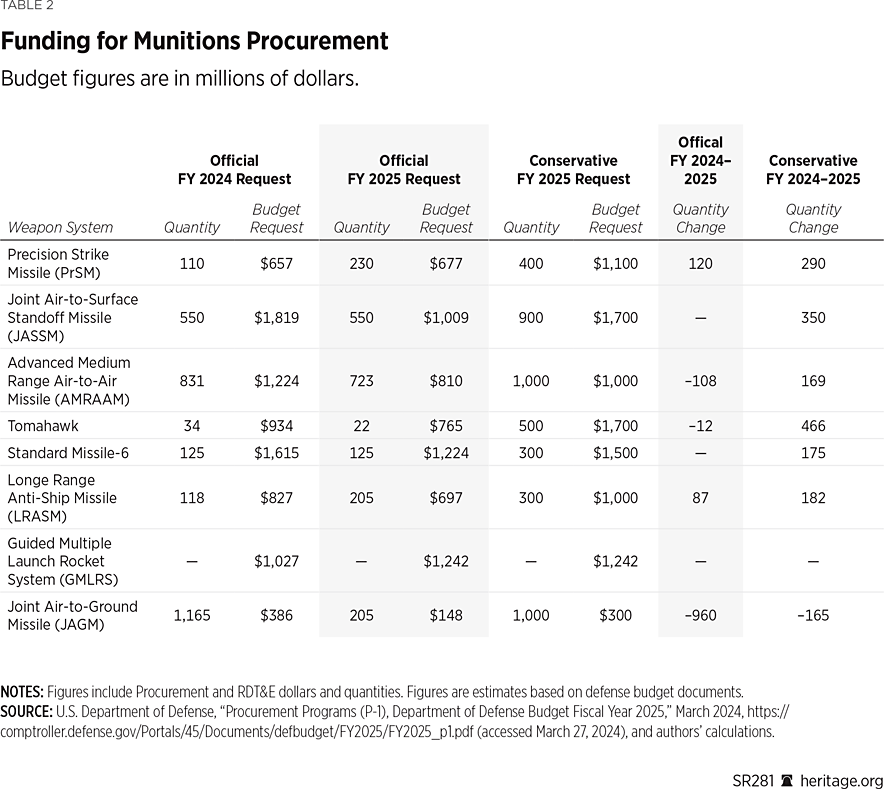
Defense Industrial Base Reforms
In response to these requests for procurement increases, critics will doubtless say that the defense industrial base is unable to handle munitions orders of this size and that they are therefore unrealistic or impossible. This criticism misses the point. Dramatically increasing the request for munitions sends a demand signal to industry that will enable it to ramp up munitions production for years to come. Purchasing munitions in block buys or using multiyear procurement authorities is even better, as it provides industry with an initial capital investment that will jumpstart increases in production capacity and encourage long-term investment in munition production.
Multiyear Procurement (MYP) Authorities. Capital investment is incredibly important to ensure U.S. munitions supply, and current production capacity is not enough to meet needs. Expanding production facilities for missiles such as JASSMs is likely to cost hundreds of millions of dollars. To be incentivized to do so, defense contractors need consistent demand signals. One way to do this is by increasing the number of multiyear contracts and the requests in those contracts. The two most consequential multiyear contracts that do not exist would be for TLAMs and MK-48 Torpedoes. Increasing the quantity of JASSMs, LRASMs, and SMs procured in multiyear contracts should also be a high priority.
Further, Congress should appropriate money that the DOD can deploy at its discretion to speed up production by investing in lower-tier suppliers and servicing other needs with which industry struggles or that industry is unable to meet.
Military Departments
The conservative defense budget shifts funding from defense-wide accounts into the Department of the Army, Department of the Navy, and Department of the Air Force. The defense budget should focus on military capability, primarily within these departments.
The Department of the Army
According to the U.S. Code:
[The Army] shall be organized, trained, and equipped primarily for prompt and sustained combat incident to operations on land. It is responsible for the preparation of land forces necessary for the effective prosecution of war except as otherwise assigned and, in accordance with integrated joint mobilization plans, for the expansion of the peacetime components of the Army to meet the needs of war.REF
The Army is operating in a budget-constrained environment even as it must restructure to support the U.S. military’s overall shift in focus to the Indo-Pacific. This reality will necessarily require the Army to make tough funding choices. Due to the nature of the situation in the Indo-Pacific, the bulk of new military funding will go to the Navy and the Air Force. To achieve its restructuring while its budget remains mostly flat, the Army will have to make significant reallocations within its own budget.
Overview of the Conservative FY 2025 Army Defense Budget. The conservative Army defense budget:
- Cuts and reallocates RDT&E spending that is not expected to deliver results in the near future or is of secondary importance.
- Focuses RDT&E spending on missile defense and intermediate-range fires programs.
- Quickly stands up the two planned remaining multi-domain task forces (MDTFs) and fully equips all five MDTFs.
- Cuts civilian positions, creating a leaner force that is less top-heavy and more focused on warfighting.
- Moves soldiers or even units into the National Guard or Army Reserve as the Army downsizes over the coming years. This will cut costs while retaining the ability to activate these forces if the need ever arises.
- Increases Family Housing spending by $100 million to improve the quality of life for servicemembers and their families.
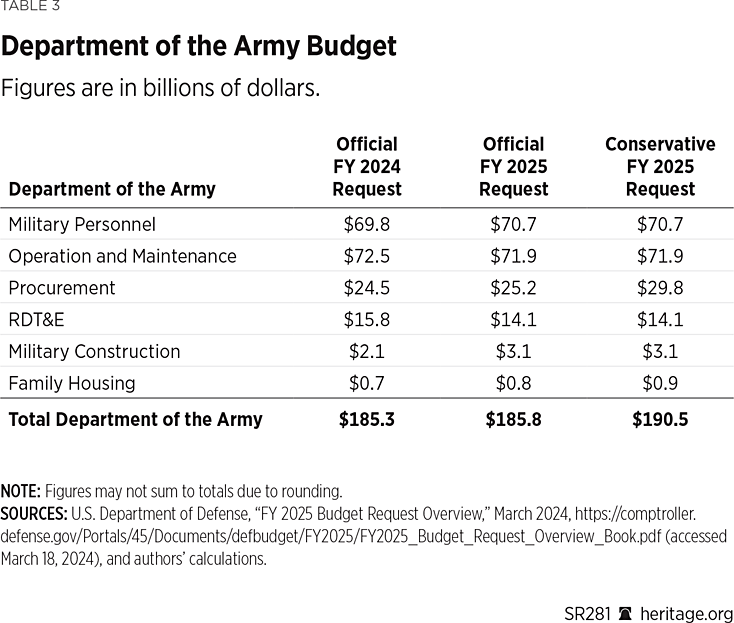
Of the three departments, the conservative defense budget’s Army budget is the most similar to the President’s budget request. The official budget keeps Army spending relatively flat and correctly shifts money out of RDT&E into procurement. The rebalancing in funding toward the Navy and Air Force is necessary given the immediacy of the challenge in the Indo-Pacific and fiscal constraints.
The primary difference between the conservative defense budget and the official request is that the conservative defense budget proposes an additional $4.6 billion in procurement spending for the Army. This additional funding is intended primarily for the purchase of munitions, including PrSM, GMLRS, and Javelin missiles.
The Army has identified and launched new initiatives that will allow it to act as a key enabler of U.S. efforts to deter China in the Indo-Pacific. The Army has launched several new modernization initiatives since 2021, including an intermediate-range capability designed to strike ships from land that will be critical to deterrence in the Indo-Pacific.
The Indo-Pacific is primarily a maritime theater in which strategically important countries are separated by hundreds or thousands of miles of open ocean. In a conflict with China, the U.S. Navy and Air Force would play the leading roles. The critical enabling role that the Army would play would be to provide logistics and air defense for forward airfields and to provide shore-based anti-access capabilities. Potential contingencies in the Indo-Pacific would require lightweight and mediumweight Army forces capable of rapid deployment that are able to employ robust air and missile defense systems, ground-launched anti-ship missiles, and long-range fires.REF
Secretary of the Army Christine Wormuth has identified five core tasks for the Army in the Indo-Pacific if war were to break out. The Army should:
- Serve as the “linchpin” service by establishing and protecting staging areas and joint operating bases for air and naval forces, including providing air and missile defense.
- Provide logistics for the joint force, especially in terms of secure communications.
- Provide command-and-control capacity.
- Use ground-based, long-range fires to interdict enemy missiles, suppress enemy air defense, and provide counter fires against mobile enemy targets.
- Provide counterattack capability with ground combat forces.REF
In the Indo-Pacific, the U.S. Army must operate in a primarily naval theater of operations against an adversary that has the home field advantage. China is hundreds of miles or less away from the potential conflict zones—as opposed to the United States’ main Pacific nodes of San Diego and Hawaii, which are thousands of miles away from the potential conflict zones—with protected interior supply lines and numerical superiority in terms of equipment and munitions in theater. The Army will have to reposition assets from other theaters to the Indo-Pacific to compensate for this structural challenge.REF
The Army’s present commitment of troops and resources in the Pacific does not match the Indo-Pacific’s status as the primary region of concern in the National Defense Strategy. The Army continues to devote as much or more of its troops and resources to other theaters, especially EUCOM and U.S. Central Command (CENTCOM), and is struggling with fully manning its units as a result of the recruiting crisis. If the Army wants to be decisive in the joint effort to deter China in the Indo-Pacific, it will need to shift personnel and resources away from other theaters to the region just as it has shifted RDT&E and Procurement dollars to programs that are more relevant to the Indo-Pacific.REF
New Weapons in the Army’s Arsenal. In 2021, the Army committed to fast-tracking and delivering multiple new fires systems by 2023. The Army has done a respectable job of meeting this target, surprising many doubters who were familiar with the Army’s failed modernization programs in the early 2000s.
Most of these new weapons and systems have been tested successfully, and U.S. Army Pacific Commander General Charles Flynn has stated that the Army is planning to deploy some of these assets to the Indo-Pacific in 2024. The Army is further developing these new weapons and systems to improve its capability to deliver long-range precision fires that would be especially relevant to a conflict in the region, including a targeting package that would enable the new surface-to-surface missile to target shipsREF
These new weapons and systems are:
- The Precision Strike Missile (PrSM).The PrSM is the next-generation surface-to-surface missile being developed by the Army to replace the Army Tactical Missile System (ATACMS).Lockheed Martin, the missile’s developer, says the missiles have a range of up to 310 miles.REF Like the ATACMS missile, the PrSM will be launched from the mobile HIMARS launch system, although the launcher will now be capable of carrying two PrSM missiles, whereas previously it could carry only one ATACMS missile.REF
- The Strategic Mid-Range Fires System. This system, also called the “Typhon” missile system, has been developed to fire anti-ship missiles, air defense missiles, and land-to-land mid-range missiles. The system is mobile and therefore difficult for enemy forces to target, and its range varies by missile type.
- The Long-Range Hypersonic Weapon (LRHW).The LRHW is set to be the U.S. military’s first long-range hypersonic missile, with a range of at least 1,700 miles. The Chinese have already deployed a significant number of hypersonic missiles and are significantly ahead of the United States. Hypersonic missiles, traveling at least five times the speed of sound, are a huge challenge for traditional air defense measures that the United States has yet to address adequately. If the Army successfully fields an LHRW battery in the near future, it will go a long way toward addressing this capability gap.
- The Multi-Domain Task Force (MDTF). The Army has introduced a new type of unit called the MDTF to accommodate these and other precision fires systems. The Army describes the MDTF as “theater-level maneuver elements designed to synchronize precision effects and precision fires in all domains against adversary anti-access/area denial (A2/AD) networks in all domains, enabling joint forces to execute their operational plan (OPLAN)-directed roles.”The 1st MDTF was established in 2017 at Joint Base Lewis–McChord in Washington State with the 2nd MDTF following in 2021 in Germany and the 3rd MDTF in 2022 in Hawaii. These units field rockets, missiles, military intelligence, and other capabilities that allow Army forces to operate seamlessly with joint partners and conduct multi-domain operations. Two more MDTFs are planned, and the Army should place these units in INDOPACOM as well.REF
The Department of the Navy
The United States, as a maritime powerhouse, has long overlooked the challenges to its naval supremacy. Rectifying this situation demands significant investments and a renewed commitment to enhancing immediate deterrence against the United States’ primary adversary: China. Considering the military landscape, naval capabilities will play a paramount role in deterring potential threats. In recent years, the Department of the Navy has been resourcing research and development at rates exceeding industry norms.REF However, these investments focus on capabilities that may not materialize for decades, rendering them ineffective for immediate deterrence needs.
The conservative defense budget emphasizes procurement in warships, aircraft, and munitions over research and development of any capability that will not reach initial operational capability before 2027. Additionally, the conservative defense budget emphasizes renewed efforts to address recruitment shortages, modernize the fleet, and expand public shipyards.
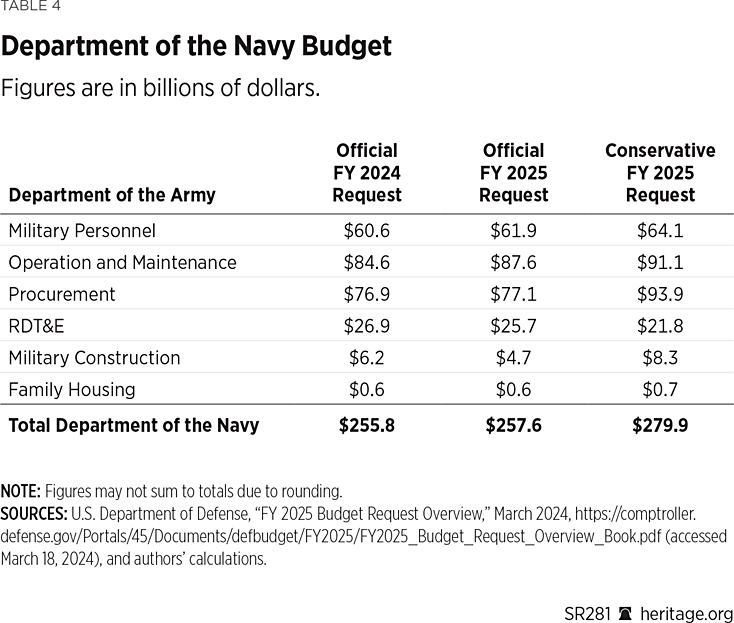
Overview of the Conservative FY 2025 Navy Defense Budget. The conservative FY 2025 Navy defense budget:
- Contains $48.1 billion for sea-power investments with new construction of nine battle force fleet ships including one Columbia-class submarine and two Virginia-class submarines, two Arleigh Burke–class destroyers, and two Constellation-class guided-missile frigates. The Navy will not retire any ships ahead of their expected service lives (ESLs).
- Is partially funded through a shift from RDT&E funding into procurement.
- Contains an increase in O&M, $2.44 billion of which is to provide funding for Red Sea operations.
- Requests no new civilian personnel.
- Increases Family Housing spending by $100 million to improve the quality of life for servicemembers and their families.
Strategic Guidance and Themes. The Navy’s primary focus must be on deterring China with a strategic emphasis on operations and military infrastructure in the Western Pacific. However, concerns are mounting about the nation’s capacity to uphold nuclear deterrence against an increasing array of threats, including China, Russia, North Korea, and potentially Iran, in the near future. The concern about North Korea’s nuclear program in particular will require the U.S. Navy to conduct relevant exercises to reassure South Korea and Japan. Furthermore, the Navy will need to deploy tactical nuclear response options (such as the SLCM-N) by 2027 and prioritize resources to ensure that the Columbia-class ballistic missile submarines enter service before the Ohio-class submarines begin to be retired from service.
Second in order of priorities is bolstering deterrence of Russia shoulder-to-shoulder with NATO allies and supporting the U.S. Coast Guard in defending U.S. and allied maritime rights and borders. This entails a specific focus on protecting America’s Pacific maritime economic exclusion zones.
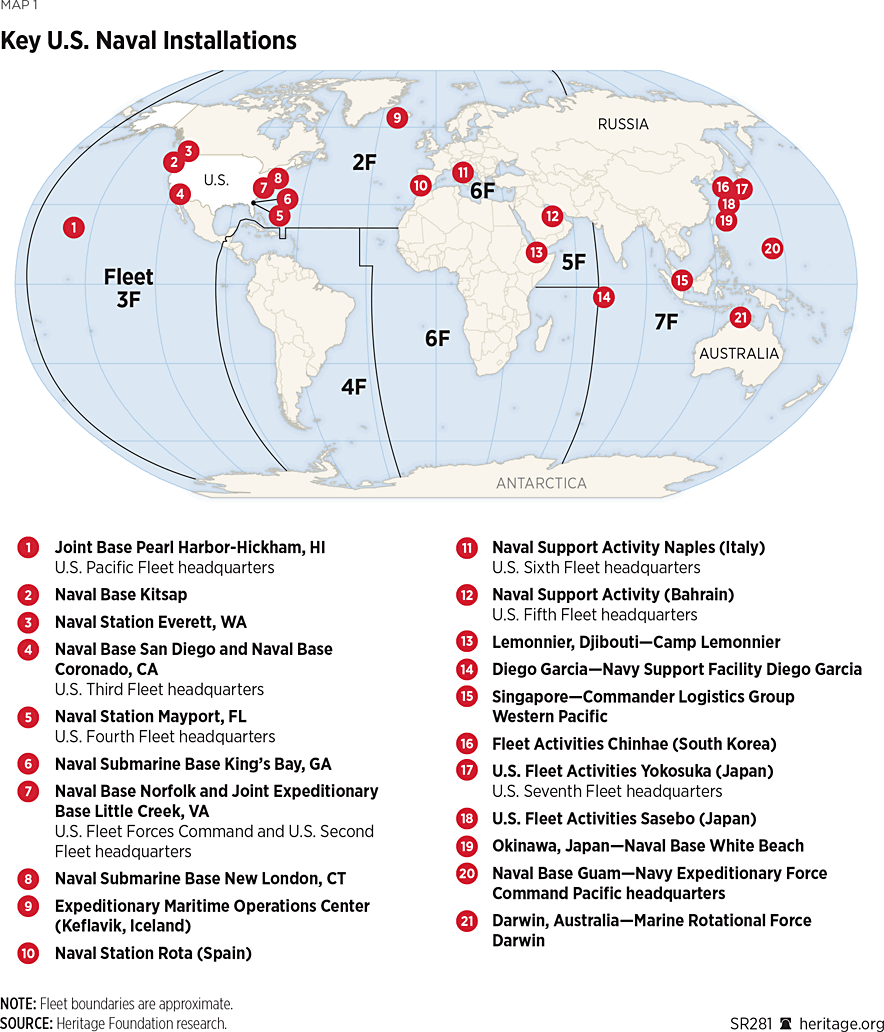
Security and Operational Environment. China’s military activities in the Western Pacific have become increasingly aggressive and persistent, especially in the waters and airspace around Taiwan. This is expected to continue while Chinese Coast Guard and paramilitary maritime militia forces continue to harass treaty allies, including the Philippines and Japan. The potential for a crisis that will engage U.S. naval forces is high. The Navy must ensure a persistent presence and readiness in these Western Pacific waters to mitigate the likelihood of a confrontation. This includes increased collaborative naval patrols and onshore activities with Pacific Island partner nations to prevent China form gaining a military foothold in the Central Pacific, including through predatory lending practices, bribery, and coercion.REF
In this decisive theater, North Korean and Russian naval activities merit continued naval presence in the Sea of Japan and the Northern Pacific. The mission of the U.S. Navy in the region will continue to be the monitoring of strategic nuclear deterrent patrols conducted by Russia’s submariner fleet as well as North Korea’s improving at-sea nuclear capability, including nuclear-capable submarine ballistic missile launches from a Golf-class submarine.
On the global front, the Navy must maintain vigilance to deter further Russian aggression alongside NATO allies. This includes ensuring adequate strike capabilities in the Eastern Mediterranean to prevent the escalation of violence into the Black Sea and providing the President with options to deter Iran and its proxies from escalating the ongoing war against Israel, which started with the attacks by Hamas on October 7, 2023.
Across the Pacific, Chinese fishing fleets have been poaching the waters of other countries, causing significant loss to livelihoods. American citizens in U.S. territories like Guam, the Mariana Islands, and American Samoa, given their proximity, could potentially be affected by this activity. Therefore, the U.S., working primarily through the U.S. Coast Guard, must increase its efforts to bolster monitoring and poaching prevention in U.S. and allied waters while deterring further Chinese encroachment in the Central Pacific. Failure to do so will significantly exacerbate the security challenges facing the U.S. in these strategically vital waters.REF
Finally, Iran’s supply of weapons and support to proxies across the Middle East creates significant threats for the U.S. and its allies. Since October 7, 2023, Israel has been at war against Hamas and has suffered repeated attacks from the Houthis in Yemen and Hezbollah across Israel’s northern border. The attacks on shipping routes by the Houthis and persistent threats by Iran to strategic waterways, including the Straits of Hormuz and Bab-el-Mandeb, are significant challenges to global shipping lanes and economic stability that require U.S. and allied naval presence. Addressing the threat to shipping in the Middle East will require a minimum naval capacity to detect and disrupt attempts at closing these waterways in concert with allies and partners. Allies and partners that are adversely affected by the attacks in the region must increase capabilities and commit resources to prevent further attacks on international shipping.
Overview of the Navy’s Budget. To address the threats that it faces, the Navy should prioritize O&M to improve readiness today. Second, more resources should be allocated to procurement of munitions—currently in short supply—that are relevant to a conflict in the Indo-Pacific. Additionally, production capacity for naval warships and new aircraft should increase to ensure that all carrier strike groups can be fully equipped. As with the other services, the Navy should partially fund additional procurement through a shift from RDT&E funding.
The O&M budget establishes a benchmark with an additional $2.44 billion allocated for operations in the Red Sea. Notably, there is a significant increase in funding for military construction aimed at expediting the modernization of public shipyards under the Shipyard Infrastructure Optimization Program (SIOP), initiating the establishment of a fifth public shipyard, and providing support for activities related to the Pacific Deterrence Initiative posture.
The U.S. Marine Corps. U.S. naval forces ensure that the U.S. can use the oceans and seas for its benefit by projecting military power in and through maritime spaces, denying the same opportunities and ability to an enemy, and assisting the larger U.S. joint force in any effort to project power ashore to accomplish war objectives. The more effectively the naval services can do this, the more they contribute to deterrence, the aim of which is to convince a potential enemy that doing things that threaten or harm U.S. interests will be more costly than the benefit they are trying to gain.
In fact, this is the Corps’ mission, defined by law: “The Marine Corps shall be organized, trained, and equipped to provide fleet marine forces of combined arms, together with supporting air components, for service with the fleet in the seizure or defense of advanced naval bases and for the conduct of such land operations as may be essential to the prosecution of a naval campaign.”REF Though the service has a long history of success in sustained land combat, its unique mission is to contribute “to the prosecution of a naval campaign.” In other words, it is a key contributor to the projection of U.S. naval power. Accordingly, its operating forces and their training, equipage, and employment concepts must account for operations in the maritime domain.
This restructuring to return the Marine Corps to projecting power in and around maritime spaces is the primary focus—encapsulated, tracked, and driven by the Corps’ Force DesignREF—that has shaped Marine Corps programs and efforts since 2019 and will continue through 2025 and several years beyond. To this end, the Corps’ budget requests have reflected investments in modernizing the force; in funding key experiment, exercise, and training initiatives; and in improving “quality of life” conditions for the force.
Substantial progress has been made in modernization and readiness, but the Corps is too small. The Marine Corps’ active component has averaged 192,000 Marines for the past 70 years,REF enabling it to field 27 infantry battalions and associated combat, combat support, aviation, and logistics capabilities to regional combatant commanders. At its present size of 172,300 Marines, it can fully staff only 21 battalions and associated capabilities. Getting back to its historical average would improve its ability to field a greater number of smaller, more capable units as envisioned by the Force Design. Of course, force expansion is predicated on associated increases in funding, improvements in the recruiting environment, and the Navy’s ability to provide more amphibious shipping.
In FY 2024, the service’s total budget (not counting aviation procurement, which is handled by the U.S. Navy) was $53.2 billion. Like its sister services, the Corps has struggled to acquire what it needs and to train as it should because defense budgets have not kept pace with inflation or the increased expense of fielding combat-credible forces as new technologies reshape the operational environment.
To account for both of these factors, as well as recovering from years of underfunding, the Corps’ budget for FY 2025 should be $56.4 billion, an increase of 6 percent: 3 percent to offset inflation and another 3 percent to see real growth that is necessary to regain capabilities and capacity. The $3.2 billion increase should be distributed as follows:
- Personnel: $0.6 billion.
- Ground procurement and training: $0.6 billion.
- Aviation O&M: $0.6 billion.
- Infrastructure repair and modernization: $1.0 billion.
- Ammunition: $0.5 billion.
The Marines are on track both in acquiring key platforms that include the joint light tactical vehicle (JLTV); the amphibious combat vehicle (ACV); and the CH-53K, F-35 B, and F-35 C systems and in introducing a range of new weapons, unmanned systems, sensors, radars, and communications equipment. The Corps has also committed to a multiyear plan to repair and modernize its supporting infrastructure that includes barracks, on-base housing, maintenance facilities, and training ranges.REF
The recommended increases for FY 2025 would not only sustain the Marine Corps’ repair and modernization, but also enable it to replenish ammunition stocks more quickly; accelerate the introduction of a host of unmanned capabilities (needed for reconnaissance, targeting, communications, and logistics); and dramatically improve the ability of ground forces to sharpen and expand their competencies in modern land warfare.REF
A major element essential to Marine Corps success in maritime operations is the fleet of amphibious warships acquired, manned, operated, and maintained by the Navy. The Corps has been consistent in stating a requirement for a minimum of 31 traditional, large amphibious warships and is now on record with a new requirement for a medium landing ship (LSM) that would be better suited to the type of operations the Corps envisions in the Indo-Pacific with an eye toward to the type of threat posed by China (though this capability would not be limited to China in its usefulness). The Corps has registered with the Navy a requirement for 35 LSMs, beginning with 18 and building to the larger number. Because the LSM was delayed from FY 2022 to FY 2025, this capability must be funded in FY 2025.REF
The Corps is in the process of building Marine Corps Base (MCB) Camp Blaz on Guam, to which 5,000 Marines will be moved from Okinawa, Japan,REF and is well on its way to fielding a new type of unit, the Marine Littoral Regiment,REF optimized to serve as a stand-in forceREF and able to conduct operations within an enemy’s weapons engagement zone (the area an enemy can target with its offensive and defense weapons). The conservative budget funding recommended for FY 2025 would support both of these important initiatives.
The Department of the Air Force
The primary role of the U.S. Air Force is established by U.S. law and DOD directive:
[The Air Force] shall be organized, trained, and equipped primarily for prompt and sustained offensive and defensive air operations. It is responsible for the preparation of the air forces necessary for the effective prosecution of war except as otherwise assigned and, in accordance with integrated joint mobilization plans, for the expansion of the peacetime components of the Air Force to meet the needs of war.REF
To that end, the Air Force executes five core missions in support of the U.S. National Security Strategy: (1) air and space superiority;REF (2) ISR;REF (3) rapid global mobility;REF (4) global strike;REF and (5) command and control.REF The ability to deter enemies in times of peace and defeat them should deterrence fail relies on high levels of capacity, capability, and readiness throughout that mission set.REF
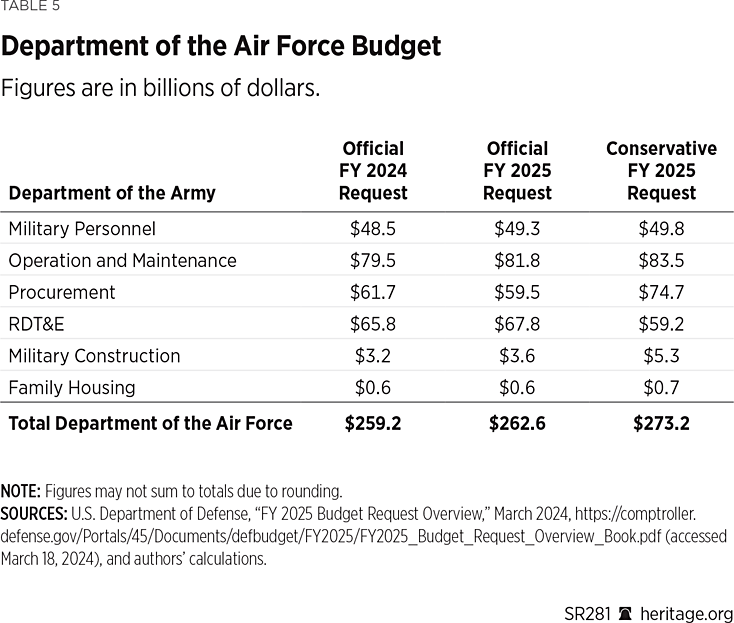
Overview of the Conservative FY 2025 Air Force Defense Budget. The conservative FY 2025 Air Force budget:
- Contains a shift in Air Force and defense-wide RDT&E to Air Force Procurement.
- Increases procurement by $15.2 billion, which includes funding for the purchase of additional F-35s and for increased munitions purchases.
- Increases operations and maintenance funding to increase pilot flying hours, which are currently far too low to maintain readiness.
- Increases Family Housing spending by $100 million to improve the quality of life for servicemembers and their families.
The Air Force has decades of decreasing budgets, and the withering effects of the global war on terrorism and the aging of the Air Force’s fleet of aircraft have reduced its capacity and readiness: In 2016, the service hit historic lows in both areas. In 2017, the Department of the Air Force (DAF) began to enjoy real budget growth that was not associated with a contingency for the first time in more than 26 years. From FY 2017 to FY 2024, the DAF’s inflation-corrected budget has grown by 37 percent,REF giving the service the opportunity to increase procurement to acquire the number of weapons systems required to compete with a rising China.REF Yet the service’s capacity and readiness levels have continued their downward trajectories.
Capacity. “The Air Force We Need” (TAFWN),REF an unclassified study released in 2018, found that the service was 25 percent too small to handle its mission set, requiring an additional airlift squadron and seven additional fighter, five additional bomber, and 14 additional tanker squadrons,REF equating to 182 fighter, 50 bomber, 210 air refueling, and 15 airlift platforms to execute the National Defense Strategy.REF To exacerbate the capacity shortfall, in 2022, the Air Force announced a plan to cut 1,468 aircraft from its fleet over the Future Years Defense Program (FYDP) with no compensating procurement plan.REF
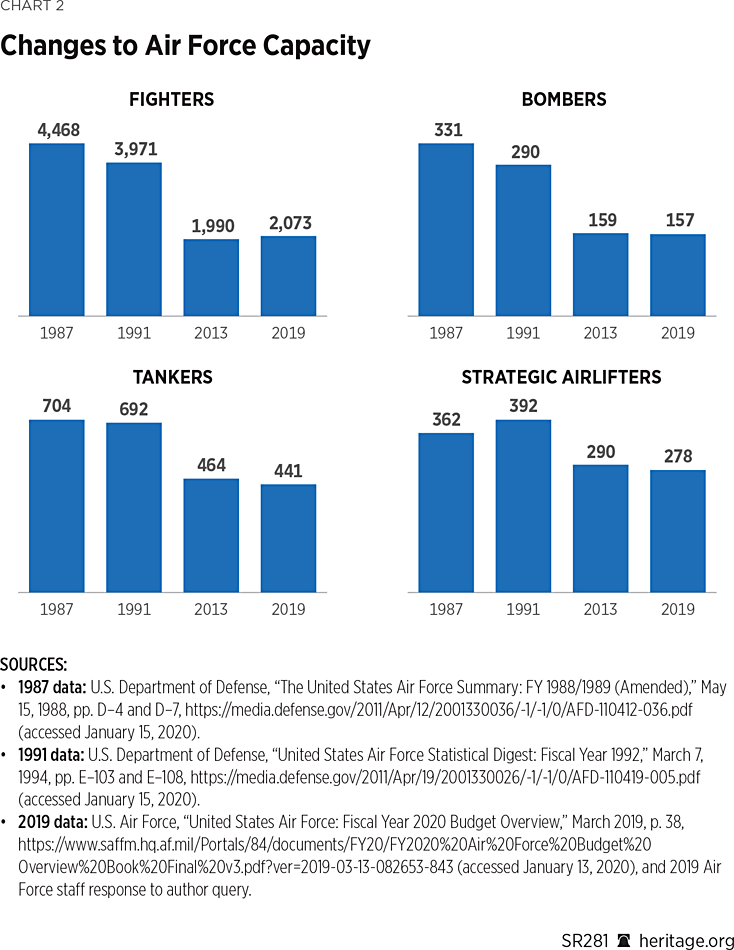
The DAF has applied the majority of the funding increase it received over the past eight years to RDT&E. Before 2017, the Air Force’s budget for RDT&E had never exceeded its budget for Procurement, but it has done so every year since then, and in the official FY 2025 request, funding for RDT&E ($67.8 billion) exceeds funding for Procurement by $8 billion.REF While the numbers for Air Force RDT&E and procurement budgets need to be rebalanced, the entire DAF budget will need to be adjusted so that both aircraft procurement and combatant air force (CAF) readiness levels can rapidly be prioritized and increased.REF
The inventory for precision-guided munitions (PGM) was severely stressed by nearly 18 years of sustained combat operations in Iraq, Afghanistan, Syria, and elsewhere and by budget actions that limited the service’s ability to procure replacements and increase stockpiles. From 2017 through 2021, funding for munitions was significant, and the service has reduced funding for munitions to a maintenance level for training. However, even though the munitions stockpile may have returned to a level that is high enough to support a surge in expenditures associated with a conflict similar to the global war on terrorism—loosely encompassing operations in Afghanistan and Iraq—it would not support a peer-level fight that lasted more than a few weeks. Funding for munitions must increase.
Readiness. The Air Force is funding fewer flying hours than it has at any other time in its history, and this has reduced readiness levels of the CAF to all-time lows. O&M funding, targeting flying hours and spare parts (Weapon Systems Sustainment), must increase incrementally but significantly over the next five years.REF
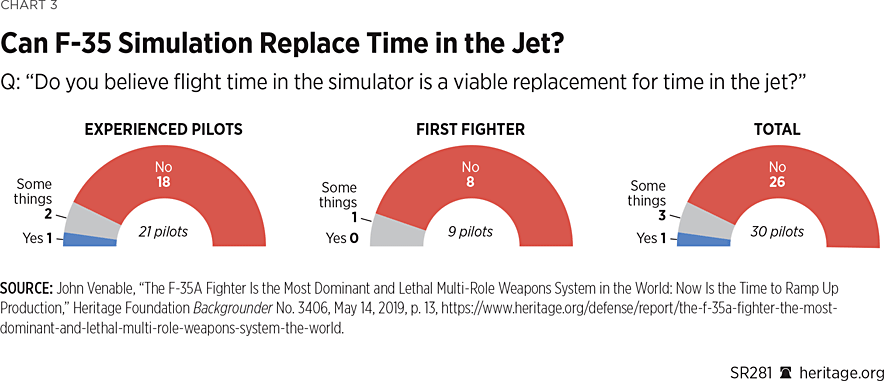
The Space Force. The Space Force’s mission is to organize, train, and equip forces “to protect U.S. and allied interests in space and to provide space capabilities to the joint force.” Its responsibilities include “developing Guardians, acquiring military space systems, maturing the military doctrine for space power, and organizing space forces to present to our Combatant Commands.”REF
The Space Force was born on December 20, 2019, and over the course of its four years of existence, it has witnessed significant growth in personnel, fielded systems, and annual budget. It now has an authorized end strength of 9,400 military and 4,909 civilian personnel. In 2018, the Air Force operated 77 satellites,REF a constellation that has almost doubled in size through service equipment transfers and additional fielding to number some 144 satellites that reside within the Space Force. Its budget has all but doubled from $15.4 billion in FY 2021 to $30 billion in FY 2024.
The Space Force’s budget for Procurement funded some of those satellites, but the vast majority came through the service’s $19.6 billion RDT&E budget. Those developmental constellations will mature over the next two years, allowing the DAF to shift some of its RDT&E funding to begin rebuilding the capacity and readiness of the Space Force’s sister service, the Air Force. To that end, the DAF should begin that process in FY 2025 by shifting $2.0 billion of the Space Force’s RDT&E budget to the Air Force’s Procurement and O&M accounts.
Conclusion
Defense spending should flow from strategy and should be focused on military capacity and lethality. Non-defense spending, politicized initiatives within the DOD, and unfocused spending all distract from the military’s core mission of defending the American people. Given the dramatic expansion of Chinese military capabilities in recent years, U.S. defense spending must focus on capabilities that are relevant to deterring China in the Indo-Pacific.
The DOD has neglected the procurement of new ships, planes, and munitions for decades. The recommendations in this Special Report go a long way toward reversing these negative trends and ensuring that the U.S. military is capable and ready to carry out its mission.
Robert Greenway is Director of the Douglas and Sarah Allison Center for National Security at The Heritage Foundation. Wilson Beaver is Policy Advisor for Defense Budgeting in the Allison Center. Robert Peters is Research Fellow for Nuclear Deterrence and Missile Defense in the Allison Center. Alexander Velez-Green is Senior Policy Advisor in the Allison Center. John Venable is Senior Research Fellow for Defense Policy in the Allison Center. Brent Sadler is Senior Research Fellow for Naval Warfare and Advanced Technology in the Allison Center. Jim Fein is Research Assistant for National Security and European Affairs in the Allison Center.
Appendix
